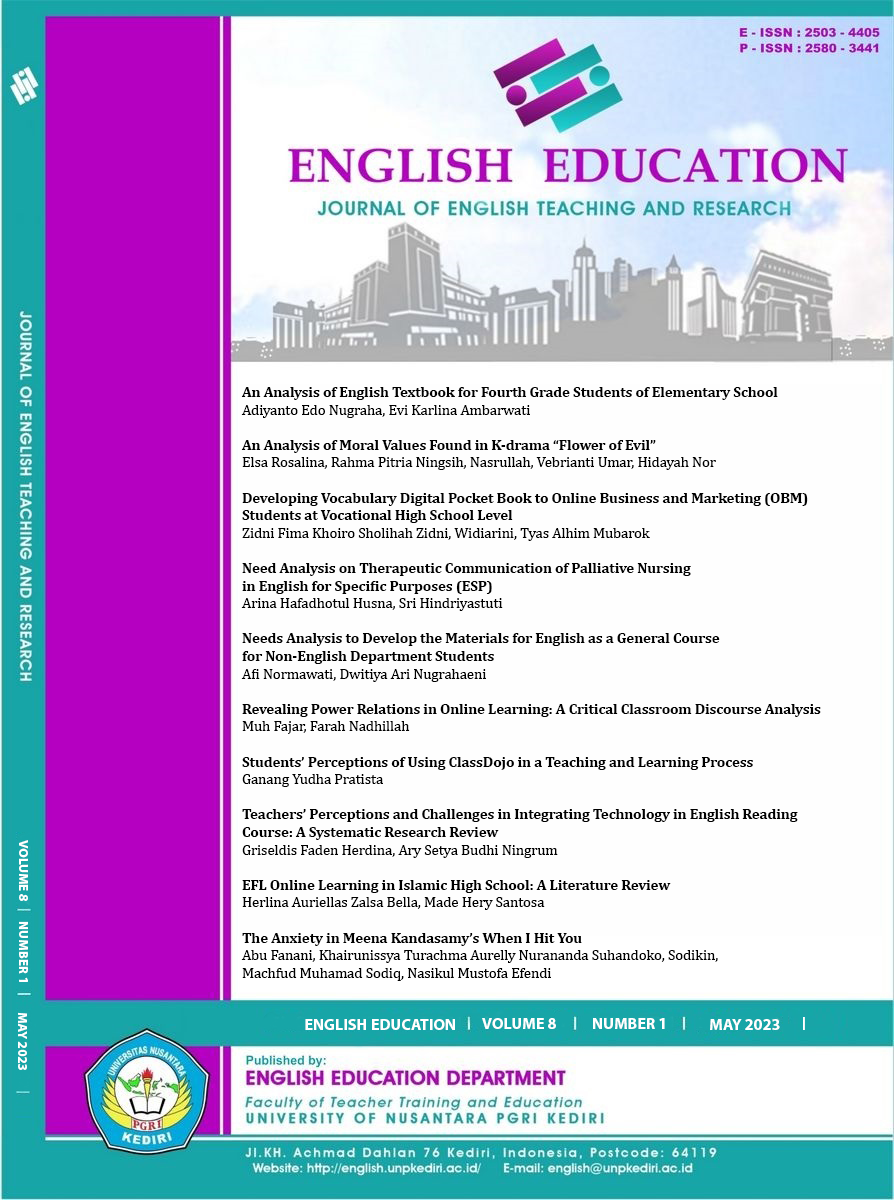Students’ Perceptions of Using Class Dojo in a Teaching and Learning Process
DOI:
https://doi.org/10.29407/jetar.v8i1.19257Keywords:
ClassDojo, Perception, Student, English Class, class dojo, perception, student, english classAbstract
In the present educational context, the teaching and learning process is gradually associated with computers to maximize its outcomes. One of the platforms which is commonly used is ClassDojo. Implementing the principles of gamification, ClassDojo is considered effective to motivate students to be more active in online classes, pushes healthy competitiveness, and enhances learning and enjoyment. This study aims to investigate the students’ perceptions of using ClassDojo in the teaching and learning process. This study applied a cross-sectional survey design in which 77 participants range from 17 to 23 years of age. To assess the perceptions, a close-ended questionnaire with five-point Likert scale was distributed and then analyzed to find out its average. Then, several interviews were carried out as the data triangulation. The result shows that there are two main components of ClassDojo which motivates students in the English class; points and avatars. The students are more motivated and engaged in the teaching and learning process as they strive to earn more points. In addition, the students are eager to customize their own character and enjoy playing it throughout the class. Thus, not only points, avatars are also the essential component of ClassDojo which motivates and engages the students in the teaching and learning process.
Downloads
References
Armanda, M. L., Nugraheni, A. F., Wulansari, A., & Imron, A. (2022). "Grammarly" as English Writing Assistant from EFL Students’ Perspective. Journal of English Teaching and Research, 128-137. DOI: https://doi.org/10.29407/jetar.v7i2.17988
Basturkmen, H. (2010). Developing Courses in English for Specific Purposes. London: Macmillan Publishers Limited.
Benhadj, Y., El Messaoudi, M., & Nfissi, A. (2019). Artificial Intelligence in Education: Integrating Serious Gaming into the Language Class Classdojo Technology for Classroom Behavioral Management . IAES International Journal of Artificial Intelligence (IJ-AI), 382-390. DOI: 10.11591/ijai.v8.i4.pp382-390
Bunchball, Inc. (2010). Gamification 101: An Introduction to the Use of Game Dynamics to Influence Behavior. White Paper.
Chou, Y.-k. (2022, November 27). The Octalysis Framework for Gamification & Behavioral Design. Retrieved from Yu-kai Chou: Gamification & Behavioral Design: https://yukaichou.com
ClassDojo. (n.d.). What's ClassDojo? Retrieved from ClassDojo: https://www.classdojo.com/about/
Gall, M. D., Gall, J. P., & R, B. W. (2007). Educational Research: An Introduction (8th ed.). Boston: Pearson.
Homer, R., F, H. K., & Y, T. C. (2018). Comparing Digital Badges-and-Points with Classroom Token Systems: Effects on Elementary School ESL Students’ Classroom Behavior and English Learning. Journal of Educational Technology & Society, 137-151.
Iftakhar, S. (2016). Google Classroom: What Works and How? Journal of Education and Social Sciences, Vol. 3, (Feb.), 12-18. https://jesoc.com/wp-content/uploads/2016/03/KC3_35.pdf
Kapp, K. M. (2012). The Gamification of Learning and Instruction: Game-Based Methods and Strategies for Training and Education. San Fransisco: Pfeiffer.
Kerriemuir, J., & Angela, M. (2004). Literature Review in Games and Learning. Futurelab. https://telearn.archives-ouvertes.fr/hal-00190453
Kumar, R. (2011). Research Methodology: A Step-by-Step Guide for Beginners (3rd. ed.). London: SAGE Publications Ltd.
Mackey, A., & Gass, S. M. (2005). Second Language Research: Methodology and Design. New Jersey: Lawrence Erlbaum Associates.
Maclean-Blevins, A. O. (2013). Class DoJo: Supporting the Art of Student Self-Regulation . Rising Tide, 1-20.
Marouf, R., & Brown, A. (2021). A Review on the Contribution of ClassDojo as Point System Gamification in Education. 20th IFIP TC 14 International Conference, ICEC 2021 (pp. 441-448). Coimbra: Springer. DOI: https://doi.org/10.1007/978-3-030-89394-1_37
Nemoto, T., & Beglar, D. (2013). Developing Likert-Scale Questionnaire. JALT2013 Conferene Proceedings (pp. 1-8). Tokyo: JALT. https://jalt-publications.org/sites/default/files/pdf-article/jalt2013_001.pdf
Salen, K., & Zimmerman, E. (2003). Rules of Play: Game Design Fundamentals. Boston: MIT Press.
Santos, J. C., & Ruiz, M. C. (2021). Using ClassDojo to Motivate Kids Participation in the English as Foreign Language Online Classes During the Covid-19 Pandemic: a Case Study. AtoZ: Novas Praticas em Informação e Conhecimento, 58-65. DOI:10.5380/atoz.v10i2.78711
Seixas, L. d., Gomes, S. A., & Filho, I. J. (2016). Effectiveness of Gamification in the Engagement of Students. Elsevier, 48-63. DOI: http://dx.doi.org/10.1016/j.chb.2015.11.021
Singh, Y. K. (2006). Fundamental of Research Methodology and Statistics. New Delhi: New Age International (P) Limited.
Sugiyono. (2013). Metode Penelitian Kuantitatif, Kualitatif, dan R & D. Bandung: Alfabeta.
Warschauer, M., & Healey, D. (1998). Computers and Language Learning: An Overview. Language Teaching / Volume 31 / Issue 02, 57-71. DOI: https://doi.org/10.1017/S0261444800012970
Werbach, K., & Hunter, D. (2012). For the Win: How Game Thinking Can Revolutionize Your Business. Philadelphia: Warthon Digital Press.
Downloads
Published
Issue
Section
License
Authors who publish with this journal agree to the following terms:
- Copyright on any article is retained by the author(s).
- The author grants the journal, the right of first publication with the work simultaneously licensed under a Creative Commons Attribution License that allows others to share the work with an acknowledgment of the work’s authorship and initial publication in this journal.
- Authors are able to enter into separate, additional contractual arrangements for the non-exclusive distribution of the journal’s published version of the work (e.g., post it to an institutional repository or publish it in a book), with an acknowledgment of its initial publication in this journal.
- Authors are permitted and encouraged to post their work online (e.g., in institutional repositories or on their website) prior to and during the submission process, as it can lead to productive exchanges, as well as earlier and greater citation of published work.
- The article and any associated published material is distributed under the Creative Commons Attribution-ShareAlike 4.0 International License








 Article template
Article template



